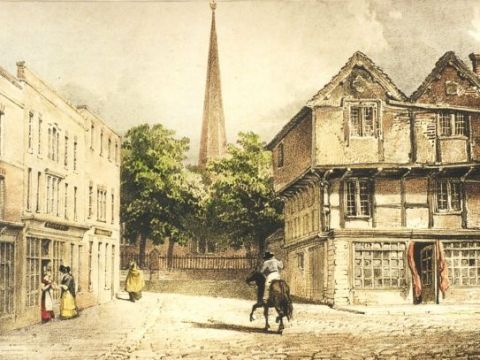Chimneys, glass and bricks
How to roughly date a building when you haven’t got a clue!
Bridgwater is a medieval town and some very old buildings still exist. One such building is the Tudor Hotel which dates from Tudor Times, 1485 to 1603. Many ordinary buildings from that period no longer exist because many were made from wood and thatch. Upmarket medieval buildings were made of more durable and expensive material such as bricks but many of those were still of poor quality. Expensive buildings were usually made of quarried stone.
The featured images is a painting by John Chubbs of the Cornhill, in Bridgwater and gives us several clues. Firstly we know when John Chubbs lived from 1746 to 1818. So lets assume John Chubb painted this image around 1780-1800. St. Mary’s Church has stood on that spot for centuries so we can’t gleam any clues from that. The building with the red curtain around the door looks distinctively older than those opposite.
Several social changes happened in Elizabethan time, 1558–1603, that can help us give this picture a rough date.
- Firstly: In around 1558, bricks became much cheaper due to technical advances and mass production. Bridgwater having the wonderfully silted River Parrett, like all industrious humans, would no doubt have made good use of this resource. In later centuries, Bridgwater became a massive brick producer and exporter. Bricks, for the first time, became a commodity of the ordinary man. This led to a huge social change, one so big that history overlooked it…. chimneys! I know that was a bit of an anticlimax. But this development did lead to lots of changes. Old medieval houses were either demolished or another level built upon it, such as I suspect in the Chubb painting where you can almost see the different structure of the bricks. Lots of examples of this type of building can be seen in England. Quite often the second story (or first if you are American) juts out over the bottom one.
- Secondly In around 1598 glass became much cheaper and within the price range of ordinary people. People who had a little money to spare would sometimes have glass windows fitted in the front of their house as a status symbol whilst still having old wooden shutters at the back, out of sight of prying eyes.
So, on what we know, the Cornhill building was probably originally medieval and maybe an expensive one for the time, having been built of what looks like quarried stone. A second story was added (post 1558), with what looks like bricks and a third story added possibly at a later date still. Windows were added probably after glass became available (post 1598) to the ordinary man.
My feel is the two stories were built on top of the original medieval structure around 1560 to 1600. The windows seem to have been added as an afterthought. I’m not an expert on Tudor style buildings but this ones seems to have some of that style which is so common for those buildings.
Unfortunately the building no longer exists, so we may never know. I’m sure there are many other clues I have missed which an expert would easily pick up on.

This fascinating investigation into a building in the interesting old town of Bridgwater appears along with many other stories here:
http://somerset-genealogy.blogspot.co.uk/
… and you can read it with comments and links here:
http://somerset-genealogy.blogspot.co.uk/2016/02/chimneys-glass-and-bricks.html

4 responses to “Chimneys, glass and bricks”
That’s interesting Lois, you should join the Architecture Appreciation Group!
LikeLiked by 1 person
I’m a little busy at the moment – but maybe when I’ve got my next book out of the way!
LikeLike
I enjoyed reading this and I think it broadens the appeal and coverage of out blog. I would enjoy more articles about ??? in addition to the stories and poetry that we already showcase.
LikeLike
Me too!
LikeLike